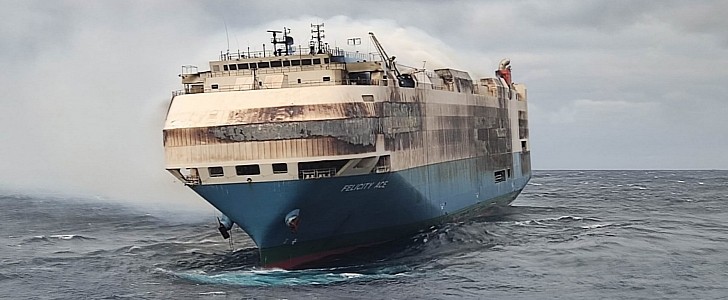Volkswagen lost any hopes of recovering some of the 4,000 cars onboard Felicity Ace, as the cargo ship sank in rough seas off the coast of Portugal. The ship was consumed by a fire that started two weeks ago in the cargo hold while en route to the United States. Despite efforts to tow it to safety, the ship sank Tuesday at 9:00 a.m. GMT.
The automotive world was in shock on February 16 when the news broke about the Felicity Ace car carrier being affected by a fire that broke out in the cargo hold. Abandoned by the crew, the ship continued to burn for days, with little hope for the rescue teams to extinguish the fire. Many cars onboard were electric vehicles, which means they had Li-Ion batteries that are notoriously difficult to extinguish in case of a fire.
One week later the fire appeared to have been put out and rescue teams were expected this week to board the ship to assess the damages. This did not happen though, as rough waters and heavy waves pushed the vessel to lean 45 degrees to its starboard side. Around 9 a.m. local time, Felicity Ace sank 220 nautical miles off the coast of Portugal’s Azores Islands, taking the 4,000 cars onboard to the bottom of the ocean.
“The weather was pretty rough out there,” Pat Adamson, a spokesperson for MOL Ship Management, a unit of Mitsui OSK Lines, said by phone to Automotive News. “And then she sank, which was a surprise.”
The ship was carrying almost 4,000 cars from the German port of Emden to Rhode Island at the time the fire started. Most of them were Audi, but also Volkswagen, Porsche, Bentley, and Lamborghini. According to dealer and Volkswagen sources, there were around 1,900 Audis, 1,100 Porsches, 500 Volkswagens, 189 Bentleys, and 85 Lamborghinis on the ship. Some of them were end-of-life limited-edition Lamborghini Aventador Ultimae, which are irreplaceable.
Volkswagen declined to comment on Tuesday. The German company had hoped at least some of the cars onboard were salvageable, but the hopes sank along with the vessel. According to Automotive News, the risk-modeling company Russell Group estimated the accident would cost the carmaker at least $155 million. There were $438 million worth of goods on the ship, of which $401 million were cars.
One week later the fire appeared to have been put out and rescue teams were expected this week to board the ship to assess the damages. This did not happen though, as rough waters and heavy waves pushed the vessel to lean 45 degrees to its starboard side. Around 9 a.m. local time, Felicity Ace sank 220 nautical miles off the coast of Portugal’s Azores Islands, taking the 4,000 cars onboard to the bottom of the ocean.
“The weather was pretty rough out there,” Pat Adamson, a spokesperson for MOL Ship Management, a unit of Mitsui OSK Lines, said by phone to Automotive News. “And then she sank, which was a surprise.”
The ship was carrying almost 4,000 cars from the German port of Emden to Rhode Island at the time the fire started. Most of them were Audi, but also Volkswagen, Porsche, Bentley, and Lamborghini. According to dealer and Volkswagen sources, there were around 1,900 Audis, 1,100 Porsches, 500 Volkswagens, 189 Bentleys, and 85 Lamborghinis on the ship. Some of them were end-of-life limited-edition Lamborghini Aventador Ultimae, which are irreplaceable.
Volkswagen declined to comment on Tuesday. The German company had hoped at least some of the cars onboard were salvageable, but the hopes sank along with the vessel. According to Automotive News, the risk-modeling company Russell Group estimated the accident would cost the carmaker at least $155 million. There were $438 million worth of goods on the ship, of which $401 million were cars.







